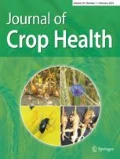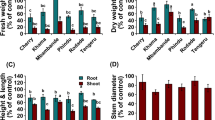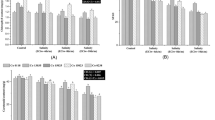Abstract
Salinity is a complex abiotic stress that affects physiology and biochemistry of plants and significantly reduces both crop yield and quality. Considering the global increase in soil salinity, it is required to develop salt-tolerant cultivars for various crops. Solanum lycopersicum L. is an important Solanaceous crop with a diverse level of genotype dependent salt tolerance. However, the evaluation of salt tolerance in tomato genotypes or screening for traits utilized reliably for breeding against salt tolerance is scarcely reported. Thirteen different genotypes of tomato were exposed to salinity with three simulated soil NaCl levels (0, 75 and 150 mM) in a complete randomized design with three pots per treatment. Morpho-physiological traits (fresh and dry weight of shoot and roots, chlorophyll content, Na+ accumulation, K+ content, Na+/K+ ratio, proline content and percent ion leakage) were measured to determine the extent of salt tolerance. Different genotypes, salinity levels and their interaction significantly influenced both the observed morphological and physiological traits of tomato. Fresh weight of shoot and root, dry weight of root and shoot, chlorophyll content, K+ content and proline content were significantly increased by Rio Grande genotype, while higher Na+ content and percent ion leakage was observed in Early King genotype. Among all tested genotypes, Rio Grande and Red Star were found salt tolerant and Early King and Vigo were found the most susceptible tomato genotypes.
Zusammenfassung
Versalzung ist ein komplexer abiotischer Stress, der sich auf die Physiologie und Biochemie von Pflanzen auswirkt und sowohl den Ertrag als auch die Qualität der Ernte erheblich reduziert. In Anbetracht der weltweit zunehmenden Versalzung der Böden ist es erforderlich, salztolerante Sorten für verschiedene Nutzpflanzen zu entwickeln. Solanum lycopersicum L. ist eine wichtige Pflanze mit einem unterschiedlichen Grad an genotypabhängiger Salztoleranz. Über die Evaluierung der Salztoleranz bei Tomatengenotypen oder das Screening nach Merkmalen, die zuverlässig für die Züchtung auf Salztoleranz genutzt werden, wird jedoch kaum berichtet. Dreizehn verschiedene Tomaten-Genotypen wurden einer Versalzung mit drei simulierten NaCl-Konzentrationen im Boden (0, 75 und 150 mM) in einem vollständig randomisierten Design mit drei Töpfen pro Behandlung ausgesetzt. Morphophysiologische Merkmale (Frisch- und Trockengewicht von Spross und Wurzeln, Chlorophyllgehalt, Na+-Akkumulation, K+-Gehalt, Na+/K+-Verhältnis, Prolingehalt und prozentualer Ionenverlust) wurden gemessen, um das Ausmaß der Salztoleranz zu bestimmen. Verschiedene Genotypen, Versalzungen und deren Interaktion beeinflussten signifikant sowohl die beobachteten morphologischen als auch physiologischen Merkmale der Tomate. Das Frischgewicht von Spross und Wurzel, das Trockengewicht von Wurzel und Spross, der Chlorophyllgehalt, der K+-Gehalt und der Prolingehalt waren beim Genotyp Rio Grande signifikant erhöht, während beim Genotyp Early King ein höherer Na+-Gehalt und ein höherer prozentualer Ionenverlust beobachtet wurde. Unter allen getesteten Genotypen erwiesen sich Rio Grande und Red Star als salztolerant und Early King und Vigo als die anfälligsten Tomatengenotypen.






Similar content being viewed by others
References
OMAFRA (2020) http://www.omafra.gov.on.ca/english/crops/facts/info_tomtemp.htm. Accessed at 05-08-2020.
Agarwal S, Rao AV (2000) Tomato lycopene and its role in human health and chronic diseases. Cmaj 163(6):739–744
Ahmad M, Khattak MR, Jadoon SA, Rab A, Basit A, Ullah I, Khalid MA, Ullah I, Shair M (2019) Influence of zinc sulphate on flowering and seed production of flax (Linum usitatissimum L.): a medicinal flowering plant. Int J Biosci 14:464–476
Al-Karaki GN (2000) Growth of mycorrhizal tomato and mineral acquisition under salt stress. Mycorrhiza 10(2):51–54
Al-Karaki GN, Hammad R, Rusan M (2001) Response of two tomato cultivars differing in salt tolerance to inoculation with mycorrhizal fungi under salt stress. Mycorrhiza 11:43–47
Alam M, Hayat K, Ullah I, Sajid M, Ahmad M, Basit A, Ahmad I, Muhammad A, Akbar S, Hussain Z (2020) Improving okra (Abelmoschus esculentus L.) growth and yield by mitigating drought through exogenous application of salicylic acid. Fres Environ. Bulle, vol 29, pp 529–535
Ali SG, Rab A (2006) The influence of salinity and drought stress on sodium, potassium and proline content of Solanum lycopersicum L. Cv Rio Grande Pak J Bot 49:1–9
Ali SG, Rab A, Khan NU, Nawab K (2011) Enhanced proline synthesis may determine resistance to salt stress in tomato cultivars. Pak J Bot 43:2707–2710
Alzahib RH, Migdadi HM, Al Ghamdi AA, Alwahibi MS, Ibrahim AA, Al-Selwey WA (2021) Assessment of Morpho-Physiological, Biochemical and Antioxidant Responses of Tomato Landraces to Salinity Stress. Plants 10(4):696. https://doi.org/10.3390/plants10040696
Amjad M, Akhtar J, Haq MAU, Imran S, Jacobsen SE (2014) Soil and foliar application of potassium enhances fruit yield and quality of tomato under salinity. Turk J Biol 38:208–218
Apse MP, Blumwald E (2007) Na+ transport in plants. FEBS Lett 581(12):2247–2254
Asghar M, Kansra V, Hussain T, Lokhandwala MF (2001) Hyperphosphorylation of Na-pump contributes to defective renal dopamine response in old rats. J Am Soc Nephrol 12(2):226–232
Ashraf M, Harris PJC (2004) Potential biochemical indicators of salinity tolerance in plants. Plant Science 166(1):3–16. https://doi.org/10.1016/j.plantsci.2003.10.024
Ashraf M, Harris PJ (2013) Photosynthesis under stressful environments: An overview. Photosynt 51:163–190
Azevedo-Neto AD, Prisco JT, Braga E (2006) Effect of salt stress on antioxidative enzymes and lipid peroxidation in leaves and roots of salt-tolerant and salt sensitive maize genotypes. Env Exp. Bot, vol 56, pp 87–94
Babu MA, Singh D, Gothandam KM (2012) The effect of salinity on growth, hormones and mineral elements in leaf and fruit of tomato cultivar PKM1. J Anim Plant Sci 22:159–164
Bajji M, Kinet JM, Lutts S (2002) The use of the electrolyte leakage method for assessing cell membrane stability as a water stress tolerance test in durum wheat. Plant Growth Regul 36:61–70
Baloch A (1994) Vegetable Crops. In Horticulture National Book Foundation. Islamabad, pp 489–509
Basit A, Khan S, Sulaiman Shah S, Shah AA (2019) Morphological features of various selected tree species on the greater university. Studies, vol 4. Campus, Peshawar, Pakistan. Int J Bot, pp 92–97
Basit A, Shah K, Rahman MU, Xing L, Zuo X, Han M, Alam N, Khan F, Ahmed I, Khalid MA (2018) Salicylic acid an emerging growth and flower inducing hormone in marigold (Tagetes sp. L.). Pure Appl Biol 7(4): 1301–1308. https://doi.org/10.19045/bspab.2018.700151
Bates LS, Waldern RP, Teare ID (1973) Rapid determination of free proline for water stress studies. Plant Soil 39:205–207
Blaha G, Stelzl U, Spahn CMT, Agrawal RK, Frank V, Nierhaus KH (2000) Preparation of functional ribosomal complexes and effect of buffer conditions on tRNA positions observed by cryoelectron microscopy. Meth Enzymol 317:292–306
Bolarín MC, Santa-Cruz A, Cayuela E, Pérez-Alfocea F (1995) Short-term solute changes in leaves and roots of cultivated and wild tomato seedling under salinity. J Plant Physiol 147:463–468
Carillo P, Annunziata GM, Pontecorvo G, Fuggi A, Woodrow P (2011) Salinity Stress and Salt Tolerance. In: Shanker A, Venkateswarlu B (eds) Mechanisms and Adaptations. org, vol 10. IntechOpen, http://dx.doi, pp 5772–22331
Cuartero J, Fernández-Muñoz R (1999) Tomato and salinity. Sci Hortic 78:83–125
Dash M, Panda SK (2001) Salt stress induced changes in growth and enzyme activities in germinating Phaseolus mungo seeds. Biol Plant 44:587–589
Delfine S, Villani AMC, Loreto F (1999) Restrictions to carbondioxide conductance and photosynthesis in spinach leaves recovering from salt stress. Plant Physiol 119:1101–1106
El-Beltagi HS, Mohamed HI, Mohammed AHMA, Zaki LM, Mogazy AM (2013) Physiological and biochemical effects of c‑irradiation on cowpea plants (Vigna sinensis) under salt stress. Not Bot Horti Agrobot 41(1):104–114
El-Beltagi HS, Mohamed HI, Sofy MR (2020) Role of ascorbic acid, glutathione and proline applied as singly or in sequence combination in improving chickpea plant through physiological change and antioxidant defense under different levels of irrigation intervals. Molecules 25:1702
El-Fouly MM, Moubarak ZM, Salama ZA (2002) Micronutrient foliar application increases salt tolerance of tomato seedlings. Proc Inter Symp On “Techniques to Control Salination for Horticultural Productivity” Eds. U. Akosy et al. Acta Hort 573: 377–385.
FAO (2015) Status of the World’s Soil Resources (SWSR)—Main Report. Food and Agriculture Organization of the United Nations and Intergovernmental Technical Panel on Soils, vol 650. FAO, Rome, Italy, pp 123–124
Fariduddin Q, Mir BA, Ahmad A (2012) Physiological and biochemical traits as tools to screen sensitive and resistant varieties of tomatoes exposed to salt stress. Plant Physiol Braz J 24:281–292
Farooq M, Ullah H, Nawab NN, Qureshi KM (2013) Evaluation of indigenous tomato hybrids under plastic tunnel. Pak. J Agric Res 26(2):97–103
Flexas J, Diaz-Espejo A, Galmés J, Kaldenhoff R, Medrano H, Carbo R, Rapid M (2007) Rapid variations of mesophyll conductance in response to changes in CO2 concentration around leaves. Plant Cell Environ 30:1284–1298
Ghonaim MM, Mohamed HI, Omran AAA (2020) Evaluation of wheat (Triticum aestivum L.) salt stress tolerance using physiological parameters and retrotransposon-based markers. Genet Resour Crop Evol. https://doi.org/10.1007/s10722-020-00981-w
Gilani SAQ, Shah K, Ahmed I, Basit A, Sajid M, Bano AS, Ara G, Shahid U (2018) Influence of indole butyric acid (IBA) concentrations on air layerage in guava (Psidium guajava L.) cv. Sufeda Pure Appl Biol 8(1):355–362. https://doi.org/10.19045/bspab.2018.700194
Gong P, Zhang J, Li H, Yang C, Zhang C, Zhang V, Khurram Z, Zhang Y, Wang T, Fei Z, Ye Z (2009) Transcriptional profiles of drought-responsive genes in modulating transcription signal transduction, and biochemical pathways in tomato. J Exp Bot 61:3563–3575
Greenway H, Munns R (1980) Mechanism of salt tolerance in non-halophytes. Annual Review of. Plant Physiol 31:149–190
Guo SW, Shen QR, Brueck H (2007) Effects of local nitrogen supply on water uptake of bean plants in a split root system. J Integr Plant Biol 49:472–480
Innocenti DE, Hafsi C, Guidi L, Izzo FN (2009) The effect of salinity on photosynthetic activity in potassium-deficient barley species. J Plant Physiol 166:1968–1981
Jan MT, Shah P, Hollington PA, Khan MJ, Sohail Q (2009) Agriculture Research: Design and Analysis, vol 1. A Monograph. Agric. Univ. Pesh. Pak, pp 232
Janda T, Darko E, Shehata S, Kovacs V, Pal M, Szalai G (2016) Salt acclimation processes in wheat. Plant Physiol Biochem 101:68–75
Juan M, Rosa M, Rivero MR, Romero L, Ruiz JM (2005) Evaluation of some nutritional and biochemical indicators in selecting salt-resistant tomato cultivars. Environ Exp Bot 54:193–201
Julkowska MM., Saade S, Agarwal G, Gao G, Pailles Y, Morton M, Awlia M, Tester M (2019) MVApp—Multivariate Analysis Application for Streamlined Data Analysis and Curation. Plant Physiology 180(3):1261–1276. https://doi.org/10.1104/pp.19.00235
Kamanga RM, Mndala (2019) Crop abiotic stresses and nutrition of harvested food crops: a review of impacts, interventions and their effectiveness. Afr J Agric Res 14: 118–135
Kavi-Kishor PB, Sangam S, Amrutha RN, Sri-Laxmi P, Naidu KR, Rao KS, Reddy KJ, Theriappan P, Sreenivasulu N (2005) Regulation of proline biosynthesis, degradation, uptake and transport in higher plants: Its implications in plant growth and abiotic stress tolerance. Curr Sci 88:424–438
Kaya C, Kirnak H, Higgs D, Saltali K (2002) Supplementary calcium enhances plant growth and fruit in strawberry cultivars grown at high (NaCl) salinity. Sci Hortic 93:65–74
Khachik F, Carvalho L, Bernstein PS, Muir GJ, Zhao DY, Katz NB (2007) Chemistry, distribution, and metabolism of tomato carotenoids and their impact on human health. Exp Bio. Medic, vol 227, pp 845–851
Khan A, Shaheen Z, Nawaz M (2013) Amelioration of salt stress in wheat (Triticum aestivum L.) by foliar application of nitrogen and potassium. Sci Tech. DEV 32:85–98
Khan TN, Jeelani G, Tariq MS, Mahmood T, Hussain SI (2011) Effect of different concentrations of rooting hormones on growth of tomato cuttings “Solanum esculentus L.”. J Agric Res 49(2):241–247
Liu J, Zhu JK (1997) Proline accumulation and salt-stress-induced gene expression in a salt-hypersensitive mutant of Arabidopsis. Plant Physiol 114(2):591–596
Loreto F, Centritto M, Chartzoulakis K (2003) Photosynthetic limitations in olive cultivars with different sensitivity to salt stress. Plant Cell Environ 26:595–601
Machado RMA, Serralheiro RP (2017) Soil Salinity: Effect on Vegetable Crop Growth. Management Practices to Prevent and Mitigate Soil Salinization. Horticulturae 3:30. https://doi.org/10.3390/horticulturae3020030
Maggio AS, Miyazaki P, Veronese T, Fujita JI, Ibeas B, Damsz ML, Narasimhan PM, Hasegawa RJ, Joly, Bressan RA (2002) Does proline accumulation play an active role in stress-induced growth reduction. Plant J 31: 699–712.
Marschner H (1995) Adaptation of Plants to Adverse Chemical Soil Conditions, In: Mineral nutrition of higher plants, 2nd edn. Academic Press, London, pp 596–680
Mir A, Ahmad M, Udin F (2013) Physiological and biochemical traits as tools screen sensitive and resistant varieties expose to salt stress. Brazilian J Plant Phyisio 24:286–292
Mohamed HI, Akladious SA, El-Beltagi HS (2018) Mitigation the harmful effect of salt stress on physiological, biochemical and anatomical traits by foliar spray with trehalose on wheat cultivars. Fresenius Environ Bull 27:7054–7065
Munns R, Tester M (2008) Mechanisms of salinity tolerance. Annu Rev Plant Biol 59:651–681
Naeem M, Basit A, Ahmad I, Mohamed HI, Wasila H (2020) Effect of Salicylic Acid and Salinity Stress on the. Pflanzen, vol 72. Performance, of Tomato Plants. Gesunde, pp 393–402 https://doi.org/10.1007/s10343-020-00521-7
Nawaz K, Talat V, Hussain K, Majeed (2010) Induction of salt tolerance in two cultivars of sorghum (Sorghum bicolor L.) by exogenous application of proline at seedling stage. World Appl Sci J 10: 93–99.
Pedro AMK, Ferreira MMC (2007) Simultaneously calibrating solids, sugars, and acidity of tomato products using PLS2 and NIR spectroscopy. Analyst Chem Act. https://doi.org/10.1016/j.aca.2007.03.036
Qadir M, Noble AD, Schubert S, Thomas RJ, Arslan A (2006) Sodicity-induced land degradation and its sustainable management: problems and prospects. Land Degrad Dev 17:661–676
Radzevičius ARP, Karkleliené Č (2009) ViSkelis, Bobinas R. Bobinaitéand, Sakalauskiene S (Tomato fruit quality and physiological parameters at different ripening stages of Lithuanian cultivars. Agro Res7: 712–718.)
Romero-Aranda R, Soria T, Cuartero J (2001) Tomato plant water uptake and plant water relationships under saline growth conditions. Plant Sci 160:265–272
Romheld V, Kirkby EA (2010) Research on potassium in agriculture: Needs and prospects. Plant Soil 335:155–180
Sajid M, Basit A, Ullah Z, Shah ST, Ullah I, Mohamed HI, Ullah I (2020) Chitosan-based foliar application modulated the yield and biochemical attributes of peach (Prunus persica L.) cv. Early Grand Bull Nat Res Centre 44:150. https://doi.org/10.1186/s42269-020-00405-w
Shahid MA, Pervez MA, Balal RM, Mattson NS, Rashid R, Ahmad R, Ayyub CM, Abbas T (2011) 2 4‑epibrassinolide enhances growth and alleviates the deleterious effects induced by salt stress in pea (Pisum sativum L.). Aust J Crop Sci 5:500–510
Sharma S, Villamor JG, Verslues PE (2011) Essential role of tissue-specific proline synthesis and catabolism in growth and redox balance at low water potential. Plant Physiol 157:292–304
Shimul MAH, Shin-ichi I, Sadia S, Roni MZK, Jamal-U-ddin AFM (2014) Response of Tomato (Lycopersicon esculentum) to Salinity in Hydroponic. Study Bangladesh Res Pub J 10:249–254
Singh RK, Redoña E, Refuerzo L (2009) Varietal improvement for abiotic stress tolerance in crop plants: special reference to salinity in rice. In Abiotic stress adaptation in plants. Springer, Dordrecht, pp 387–415
Sofy MR, Elhawat N, Alshaal T (2020a) Glycine betaine counters salinity stress by maintaining high K+/Na+ ratio and antioxidant defense via limiting Na+ uptake in common bean (Phaseolus vulgaris L.). Ecotoxicol Environ Safety 200:11073
Sofy MR, Elhindi KM, Farouk S, Alotaibi MA (2020b) Zinc and paclobutrazol mediated regulation of growth, upregulating antioxidant aptitude and plant productivity of pea plants under salinity. Plants 9(9):1197
Sudhir P, Murthy SD (2004) Effects of salt stress on basic processes of photosynthesis. Photosynt 42:481–486
Szabados L, Savoure A (2010) Proline: A multifunctional amino acid. Trends Plant Sci 15:89–97
Tariq S, Bano B, Saleem MM (2010) Physiological and molecular studies of tomato under salinity stress. South African. J Biotech 3:112–119
Tester M, Davenport R (2003) Na+ tolerance and Na+ transport in higher plants. Ann Bot 91:503–527
Tigist M, Workneh TS, Woldetsadik K (2013) Effects of variety on the quality of tomato stored under ambient conditions. J Food Sci Tech Mys 50:477–486
Ueda A, Kanechi M, Uno Y, Inagaki N (2003) Photosynthetic limitations of a halophyte sea aster (Aster tripolium L.) under water stress and NaCl stress. J Plant Res 116:65–70
Wakeel A, Sumer MJS, Hanstein YF, Schubert S (2011) In vitro effect of different Na+/K+ ratios on plasma membrane H+-ATPase activity in maize and sugar beet shoot. Plant Physiol Biochem 49:341–345
Wang M, Zheng S, Shen Q, Guo S (2013) The Critical Role of Potassium in Plant Stress Response. Int J Mol Sci 14:7370–7390
Watad AE, Pesci PA, Reinhold L, Lerner HR (1986) Proton fluxes as a response to external salinity in wild type and NaCl adapted Nicotiana cell lines. Plant Physiol 81:454–459
Willcox JK, Catignaniand GL, Lazarus S (2003) Tomatoes and cardiovascular health. Crit Rev Food Sci Nutr 43:1–18
Yurtseven E, Kesmez GD, Unlukara A (2005) The effects of water salinity and potassium levels on yield, fruit quality and water consumption of a native central Anatolian tomato species (Lycopersicon esculentum). Agri Water. Management 78:128–135
Author information
Authors and Affiliations
Corresponding author
Ethics declarations
Conflict of interest
The authors declare no conflict of interest.
Supplementary Information
10343_2021_576_MOESM1_ESM.docx
Supplementary Table 1: Soil Physical and Chemical properties; Supplementary Table 2: Pearson correlation for morphological and physiological attributes of tomato genotypes.
Rights and permissions
About this article
Cite this article
Ur Rahman, S., Basit, A., Ara, N. et al. Morpho-physiological Responses of Tomato Genotypes Under Saline Conditions. Gesunde Pflanzen 73, 541–553 (2021). https://doi.org/10.1007/s10343-021-00576-0
Received:
Accepted:
Published:
Issue Date:
DOI: https://doi.org/10.1007/s10343-021-00576-0




